| When I was
a kid growing up in the
East End of London in the
late 1940s and early
1950s, every
neighbourhood had a large
number of cinemas where
people went to see the
latest films produced in
Britain and Hollywood. By
this time, these films
were on what was called General
Release and were
being shown at the local
cinemas at what was
euphemistically called popular
prices. Prior to
this, most of the films
had been showcased
in the West End of London
for a variable period of
time. Here people paid premium
prices to see these
films in some comfort.
Their run in a
West End cinema depended
strictly on the number of
tickets sold. Once ticket
sales declined, the film
would go into General
Release and be sent
out on circuit.
Most local cinemas formed
part of the bigger circuits
and showed the films for
one week at the so-called
popular prices. At
that time, it was rare
for a film to be held
over for longer than one
week and even rarer for
one to return to the circuit
after completing its
tour. I can only remember
two films that did this
during my childhood: The
Third Man and The
Great Caruso. Later,
film companies realized
the value of re-release
and various double
bills of previously
popular films became
quite common. Naturally
the circuits existed
to make their owners
money, but they afforded the
average working man
the chance to see a wide
range of films at a
cheaper rate and to have good
night out while doing
so. In those days, most
people were not in a
position to pay the unpopular
prices demanded by
the showcase
cinemas in the West End.
I found it most annoying
to be denied seeing these
films when they first hit
the screen since the
cost of a ticket up
West was certainly
prohibitory to me. Having
a definite lack of
patience, it vexed me
somewhat that I was
expected to wait to see
the films that took my
fancy until they had
not only been shown in
the pre-circuit
cinemas as well as
those of the North
West of London before
they finally came to rest
in North East London,
which included the East
End. Mind you, had I
lived in South
London, I would have been
required to wait another
week since they were
granted screening last of
all. Still, since I had
little respect for
South London, I
had little sympathy for
these people. However, I
was willing to let them
have the scrapes and
crumbs that fell from the
table once I had feasted.
Although time has taught
me to have a certain
patience, I fear that my
feelings towards South
London has changed
little in the interim.
In
the late ‘40s and
early ‘50s, middle
class folks went to the cinema
while I, a member of the
working class, went to
the flicks or pictures
and did so whenever I
could. The British public
did not go to the
movies. This was an
affectation that had not,
as yet, made its way into
the vernacular. People
still listened to the
Radio for entertainment
in the evenings and
enjoyed the varied
programming offered by
the B.B.C., which had no
competition at that time.
Although television sets
were for sale, television
was yet to worm its way
into the psyche of the
populace since few people
could afford to buy one.
As a result, going to the
pictures was the most
popular way people spent
their evenings out. Like
them, I used to love
going to the pictures
and enjoyed all kinds of
films. However, my
favourites were those
that contained sword
fighting. I still
marvel at the dexterity
displayed by Errol Flynn
and Tyrone Power whenever
I watch their films.
Although I enjoyed cowboys
and Indians,
according to my parents,
I would become too
involved and was known to
leap from my seat and run
towards the screen
yelling words of
displeasure when it
became clear that the
Indians were about to
lose the battle. I always
sided with the Indians
and still do.
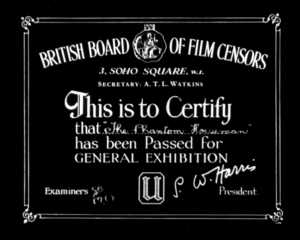 As
a child, I would have
gone to the pictures to
see everything,
but since I was still
young, I had to wait to
go with my family or with
my mother on her
occasional night off from
the shop. I was
allowed to go with
friends whenever there
was a children’s
programme showing.
This would generally mean
a Walt Disney
full-length cartoon, period
dramas, comedies and
Westerns. All such films
would carry a U
certificate. The British
Board of Film Censors
who met in Soho Square
made the decision as to
who could see a film and
under what conditions.
The designation U
meant that anyone could
see this film without the
necessity of being
accompanied by an adult.
An adult, in this case,
meant anyone of 16 years
or older. Imagine calling
a 16-year-old youth of
today an adult!
Preceding the showing of
films of that epoch, a
copy of the British
Board of Film
Censors’ Certificate
had to be shown by law
and would include the
film’s designation
and the Board’s
address, which was in
Soho. Even at my young
age, I knew that Soho
was an area of London
reserved for certain
types of entertainment
not readily available
elsewhere. Here, my
imagination would always
take over and I would
envision the members of
the Board enjoying such
entertainment between the
screenings. Unlike most
kids who wanted to grow
up to be firemen or
engine drivers, I wanted
none of these
occupations. No, I wanted
to grow up to be a member
of the British Board
of Film Censors. As
a child, I would have
gone to the pictures to
see everything,
but since I was still
young, I had to wait to
go with my family or with
my mother on her
occasional night off from
the shop. I was
allowed to go with
friends whenever there
was a children’s
programme showing.
This would generally mean
a Walt Disney
full-length cartoon, period
dramas, comedies and
Westerns. All such films
would carry a U
certificate. The British
Board of Film Censors
who met in Soho Square
made the decision as to
who could see a film and
under what conditions.
The designation U
meant that anyone could
see this film without the
necessity of being
accompanied by an adult.
An adult, in this case,
meant anyone of 16 years
or older. Imagine calling
a 16-year-old youth of
today an adult!
Preceding the showing of
films of that epoch, a
copy of the British
Board of Film
Censors’ Certificate
had to be shown by law
and would include the
film’s designation
and the Board’s
address, which was in
Soho. Even at my young
age, I knew that Soho
was an area of London
reserved for certain
types of entertainment
not readily available
elsewhere. Here, my
imagination would always
take over and I would
envision the members of
the Board enjoying such
entertainment between the
screenings. Unlike most
kids who wanted to grow
up to be firemen or
engine drivers, I wanted
none of these
occupations. No, I wanted
to grow up to be a member
of the British Board
of Film Censors.
At that
time, a children’s
programme gave patrons
good value since it
included a newsreel, a
cartoon, trailers for
next week’s films
along with two full
length feature films.
We would be in the cinema
for three hours of more
with the opportunity of
staying to some of the
offerings a second time.
The films would generally
be action packed,
which kept the kids
happy. Kids like to sit
at the front of the
auditorium. They want to
be close to the action.
Since kids also enjoy
showing their feelings,
we would hoot and howl
and talk over the
dialogue during the love
scenes. We were
intolerant of
interruptions to the
action and would quickly
lose interest in the goings-on
on the screen
whenever the hero became
distracted from his goal
thanks to the
questionable charms of
some starlet with little
acting ability. We would
quickly find other
pursuits to follow until
the hero would remember the
job in hand and leap
back on his horse or else
draw his sword and go off
and challenge some n’er
do well and right
all wrongs. During
these annoying
interludes, an occasional
disagreement would ensue
between several of my
fellow patrons. It would
soon become evident that
their differences could
not be solved except by a
fight. This would cause
much interest by those in
the surrounding rows and
would continue until an usher
or usherette
arrived to break it up.
By then, the love scene
was long since over and
our attention would
quickly be returned to
the action on the screen.
During the
evening performances, courting
couples would favour
the last row of the
stalls and of the
balcony. Married folks
with or without their
children would sit in the
mid-stalls or at the
front of the balcony.
When I accompanied my
parents to the cinema on
a Thursday evening, we
would always sit in the
stalls. At my
mother’s insistence,
she would sit at the end
of a row on the aisle and
I would sit between my
parents. Once suitably
installed, I was eager
for the evening’s
entertainment to begin.
As you will soon tell, I
took my cinema-going very
seriously and was
intolerant of any person
or situation that
interfered with my
pleasure once the showing
had begun.
Latecomers
were barely tolerated by
me. The usherette with
torch on to light the way
would rush these patrons
to empty seats at the
front close to the
screen. These were seats
that such patrons would
not normally choose since
here they would be forced
to look up at the
screen during the
performance. This
unpleasant necessity
would cause them to
suffer a marked neck
pain, which they would
endure for several days. En
route to their seats,
and while stumbling down
the aisle, they would
complain to the usherette
about being shown to such
seats. Naturally, no one
had sympathy for them,
least of all me, since
their passage down the
centre aisle brought
disruption to those
already seated and who
were now enjoying the local
adverts provided by Pearl
& Dean et al or
the Newsreel. It was
generally felt that their
misfortune was of their
own doing and I would be
quick to voice this
feeling as they passed
us, which would generally
bring me a slap on the
legs together with a
warning to be quiet. I
resented being chastised
in such a manner
especially since I was
merely voicing the
feeling of those about
me. Well … they
should have arrived
sooner.
Much as I
disliked latecomers, the
full weight of my wrath
and my maximum
intolerance were saved
for those exceptionally
tall or fat patrons who dared
to sit directly in front
of me. This was something
not to be tolerated. Even
at my young age, I was
never fearful of allowing
my complaints to be heard
by those that were
offensive to me despite
suffering for them later
at the hands of my
parents. My comments on
their excessive girth or
height often caused a
disagreement to develop
between my mother and the
offended party. This was
easily and most often
solved by their
moving seats and so
giving me back my
unimpeded view. Another
group that irritated me
intensely was/were?
patrons who could not sit
through a film without
feeling the necessity to
get up. Generally at a
crucial point in the
film, they would find
themselves seized with
an uncontrollable desire
to get up and push their
way along the aisle. Woe
betide these
unfortunate souls for I
would do my best to
impede their passage and
make their journey as
difficult as possible. As
I said earlier, I took my
early cinema-going very
seriously and did not
like any interruption
once the showing
had begun.
There
would be an interval
prior to the showing of
the main feature film.
This time was used for
the selling of ice cream
and cold drinks in
reasonably sized cartons
containing no ice. These
were wonderful days
before the sale in
Britain of buttered
popcorn and vast
drink containers loaded
with rattling ice cubes.
I used to have a very
difficult time going to
the movies in the
U.S. because of these
products. Most of the
audience would roll into
the auditorium loaded up
with vast great tubs of
this food along with huge
great containers of drink
and proceed to munch,
crunch and slurp
their way through the
entire showing. This, I
could barely tolerate,
but the smell of that
rancid butter used to
make this loathsome free
food made me nauseous
to the point that I would
have to leave the multiplex.
As a child, I liked the choc-ice
best of all from the
delights on offer from
the saleslady’s
tray. However, what
displeased me about this
particular treat was that
it needed to be eaten
quickly or else the
melted cream would drip
down my fingers and onto
my clothes much to the
annoyance of both my
mother and I. I would
always debate whether to
have this treat or go
with the tub. If only
today’s decisions
were that simple.
Once the
interval was over and the
patrons were finishing up
their purchases, the
house lights of the
auditorium would begin to
dim in final preparation
of the screening of the
main feature. It was
at this point that the
courting couples would make
themselves comfy.
Now, as the house lights
dimmed and as the
curtains slowly swooshed
open, hands would
quickly be taken and
held, men’s arms
would slide around the
shoulders of their
companions and first
kisses would be stolen
during that first moment
of darkness. No doubt the
frequency and intensity
of the kisses would
increase for the
fortunate especially
should the film prove
dull. If the man was lucky,
other delights
might be made available
to him, as long as no one
was looking that is.
I remember
that the kids of the area
were severe critics and
not easily impressed.
Likes and dislikes were
strongly felt. Certain
things and places were
held in high esteem while
others were deemed
unworthy of attention and
dismissed with a wave of
the hand. I was no
different to the other
kids, except that perhaps
I was a mite more
opinionated and perhaps a
little more willing to
share my views. To
illustrate my point, Woolworths
was held in high regard
since it was a virtual Aladdin’s
cave for a child.
Where else could a
customer purchase a
brightly coloured
facemask for sixpence?
Where else were balloons
sold for three-a-penny?
Bombed sites were
also cherished
havens. These sites were
readily found all over
the East End and the City
when I was a child. To
adults, these sites were
eye-sores and constant
reminders of the recent
war, and they looked
forward to the day when
the site would be filled
with buildings and
houses. However, to us,
they were places where we
could play without
hindrance from adults. Of
course these sites were
dangerous. Certainly we
risked getting hurt
should we fall while
running along a broken
wall. But we saw no
danger. To us they were
places where our
imaginations could run
riot and where
wondrous games were
devised and played. When
I visit London and walk
through old
neighbourhoods,
especially the Barbican,
I am horrified that the
sites where I once ran
free have been replaced
by such dross and rubbish
buildings.
As kids,
we held going to the
cinema highly and worthy
of our attention. Besides
the children’s
programme, there was
also Saturday Morning
Pictures to look
forward to each week. One
of the cinemas of the
neighbourhood would open
its door on a Saturday
morning to the kids, and
for a special price,
we could pass away our
morning by watching a
serial, several cartoons
and a feature film.
Although the programme
could never be considered
especially thrilling, we
all enjoyed ourselves. I
found the very act of
going to the cinema, as
did many of my cohorts,
to be exciting and held the
cinema in high
standing. Besides, it
should be remembered that
just going into certain
cinemas proved to be a never-to-be-forgotten
experience since many
were not just places to
see moving images
projected onto a screen.
Many were in fact works
of art and startling to
see. As a child, and even
now, I was willing to
travel what was
considered then to be
long distances to visit a
picture palace.
 When
I was a child, going
to the pictures was
still a major way to
spend an evening. Most
neighbourhoods in the
East End had a variety of
cinemas for the
entertainment and
pleasure of the
inhabitants. At that
time, there were two
major cinema circuits in
Britain, The Rank
Organization and
Associated British
Cinemas (ABC) who between
them owned or contracted
with most of the cinemas.
There were several other
smaller circuits, but
were no match When
I was a child, going
to the pictures was
still a major way to
spend an evening. Most
neighbourhoods in the
East End had a variety of
cinemas for the
entertainment and
pleasure of the
inhabitants. At that
time, there were two
major cinema circuits in
Britain, The Rank
Organization and
Associated British
Cinemas (ABC) who between
them owned or contracted
with most of the cinemas.
There were several other
smaller circuits, but
were no match 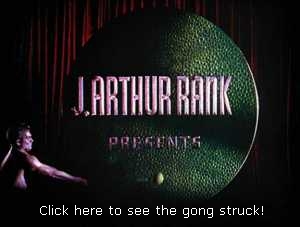 since
they had to content
themselves by showing
revivals or those films
not wanted by the major
circuits. No matter what
the size of the cinema,
its state of grandeur or
its affiliation, they
were all single screen
houses for the multiplex
had not, as yet, arrived
on the scene to chop up
and dismember them, thank
God. since
they had to content
themselves by showing
revivals or those films
not wanted by the major
circuits. No matter what
the size of the cinema,
its state of grandeur or
its affiliation, they
were all single screen
houses for the multiplex
had not, as yet, arrived
on the scene to chop up
and dismember them, thank
God.
Rank and
ABC owned the
distribution rights to
most Hollywood and
British films at that
time and had their choice
of the premier
films made and so their
cinemas became the most
popular ones attended.
Most of their cinemas
were large and richly
decorated, which was a
further attraction to the
patron. Rank mostly named
their cinemas Gaumonts
and Odeons.
Sometimes other names
were used, as was the
case with the Troxy found
on the Commercial Road in
Stepney or with
the Regent in
Brighton, both of which
were part of the Gaumont
group. The Troxy was
a fine cinema and was the
closest thing to a picture
palace in my area.
Sadly once going to
the pictures fell out
of favour in Britain it
closed, but later for a
number of years, it was
used by the Royal Ballet
Company as a rehearsal
and storage site. In most
cases, whenever a cinema
was known by a unique
name, such as the Museum
in Bethnal Green, it was
generally so named when
first built prior to its
association with a
circuit. The circuits
tended to leave these
names intact so as not to
antagonize anyone and so
risk losing regular
patrons. After all, the raison
d’etre of a
circuit, and for any
cinema owner for that
matter, was to make a
profit.
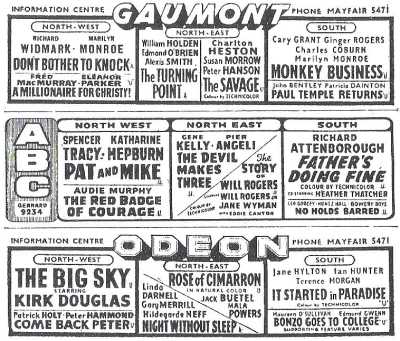
Odeons,
Gaumonts and ABCs
were represented
throughout the country
and many would rank among
the most grand. Each
cinema was constructed to
a unique design in the
style specified the
original parent circuit.
However, some cinemas
would have been acquired
from other defunct
independent chains and
would quickly acquire
certain accoutrements
that would leave the
patron in no doubt as to
its new association and
owner. And so the cinemas
of each of the circuits
throughout the country
would be easily
recognizable, however
each would have to
undergo some minor
variation to the general
architectural theme and
so take on a unique
quality that would make
it special to its
faithful clientele.
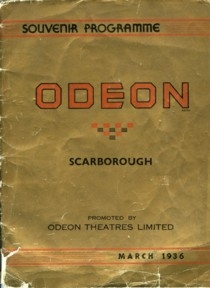 The
Odeons were
without doubt my
favourite cinemas since I
liked their design and
décor. Even as a child
their very understatement
suggested grandeur to me
and I found them to be
the most appealing of all
cinemas. The first Odeon
circuit of cinemas was
founded by Oscar Deutsch
in 1930. It is widely
believed that the name Odeon
is an acronym from the
declaration …. Oscar
Deutsch
Entertains
Our
Nation.
However the name had
been used by a number of
cinemas in Europe prior
to this date and a National
Theatre in Paris had
used it for many years
preceding this. The
interiors of the numerous
Odeons were soon
seen as remarkable
examples of the art deco
style of the 1930s. The J.A.
Rank Organization
acquired the cinemas in
1938 following Mr.
Deutsch’s death and
would operate them,
together with the Gaumont
chain, until 2000
when the organization
sold their cinemas and
ended its association
with the film industry. The
Odeons were
without doubt my
favourite cinemas since I
liked their design and
décor. Even as a child
their very understatement
suggested grandeur to me
and I found them to be
the most appealing of all
cinemas. The first Odeon
circuit of cinemas was
founded by Oscar Deutsch
in 1930. It is widely
believed that the name Odeon
is an acronym from the
declaration …. Oscar
Deutsch
Entertains
Our
Nation.
However the name had
been used by a number of
cinemas in Europe prior
to this date and a National
Theatre in Paris had
used it for many years
preceding this. The
interiors of the numerous
Odeons were soon
seen as remarkable
examples of the art deco
style of the 1930s. The J.A.
Rank Organization
acquired the cinemas in
1938 following Mr.
Deutsch’s death and
would operate them,
together with the Gaumont
chain, until 2000
when the organization
sold their cinemas and
ended its association
with the film industry.
The décor
of Odeons was in
chocolate brown and gold,
which gave them an
extremely classy
look. There would be a
thick chocolate brown
carpet with gold motif
throughout the cinema
that the patron’s
foot would sink into and
which would add to the
luxurious atmosphere
created by the subtle
décor and lighting. The
ushers and usherettes
were smartly dressed in
matching ensembles in the
colours of the chain and
were readily attentive to
the patrons’ needs.
No matter which Odeon a
patron attended, he or
she would be certain to
feel that their visit
gave them a sense of
occasion.
Gaumont
cinemas were also
part of the J.A. Rank Organization
when I was a child, but
the roots of their parent
organization came into
effect in 1922 when Gaumont,
a French company
established a film studio
at Shepherds Bush,
London. Gaumont
British Pictures
merged with Gainsborough
Pictures in 1927 and,
in 1931, assumed control
of Provincial
Cinematograph Theatres.
The Gaumont British
Picture Corporation
operated these cinemas
until 1941 when Rank began
operating some of them.
In 1949 the Gaumont and
Odeon circuits
merged to form the Circuits
Management Association.
Despite this merger, each
circuit operated
separately and did not share
distribution of films
until the company was
sold to Cinven in
2000.
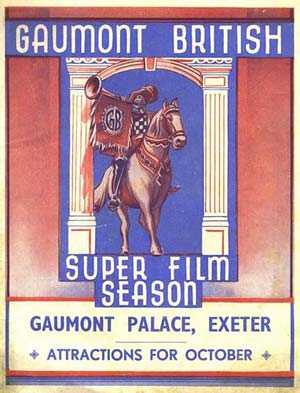
Although Gaumonts
were the poor relation
of the Rank
Organization,
nonetheless some were
grand and a number of
truly remarkable picture
palaces formed part
of the Gaumont circuit.
Among those known to me
include the spectacular Regent
in Brighton (now sadly
demolished) and the State
in Kilburn (still
standing and recently
sold to a church
organization).
Despite
the many architectural
splendors that could be
found among the Gaumont
cinemas and even
with having seen many
excellent films in
cinemas of the circuit, I
have to confess that I
have never found an average
Gaumont to compare
in either décor or
architecture to an average
Odeon. But then I
also have to confess to
never having actually
seen an average Odeon.
ABC
Cinemas was formed in
1927 in Scotland by John
Maxwell. During the
1930s, the company grew
in size by the building
of new cinemas and by the
purchase of others. Of
special significance were
those of Union Cinemas
in 1937, which were one
of the first luxury
town-centre circuits. The
chief architect of ABC
cinemas was W.R. Glen who
was responsible for their
unique style. In 1937, ABC
Cinemas became the Associated
British Picture
Corporation and in
1940, Warner Brothers purchased
a majority of shares. The
cinemas at this time were
generally called Savoy
or Regal. The ABC
cinemas that I knew
in my area of the East
End of London known as
the Empire or else
had no apparent name, as
was the case of a small
cinema on the Commercial
Road in Stepney.
ABC
cinemas were generally grand
in décor and
architecture and were,
like the Odeons,
remarkable examples of
art deco. Although there
was much to recommend
these cinemas in their
design, I was never one
to be overwhelmed by
them. I did not like the
colour scheme. The décor
of the foyer, access
halls and corridors to
the auditoria appeared to
be of a basic beige or
cream, which I did not
find to be a particularly
appealing colour. In the
foyer, advertisement
boards and picture
holders along with
various other accessories
were found. These were
decorated with intricate
motifs, patterns and
designs and served to
accentuate the unique
décor of the cinema
chain. Although this made
for a remarkable and
interesting sight, I felt
the overall effect was
spoilt by the
unattractive combination
of red, gold and green
paints used to highlight
them. This choice of
colour together with the basic
beige failed to win
me over and I felt
the final effect to be cold
and somewhat eerie
causing me not to want
to enter the
auditorium. As I have
said, I much preferred
the lush richness and warmth
produced by the
combination of the
chocolate brown and gold
favoured by the Odeons.
However, one thing that
did impress me at the ABC
were the lamps and recess
lighting, which were
often spectacular.
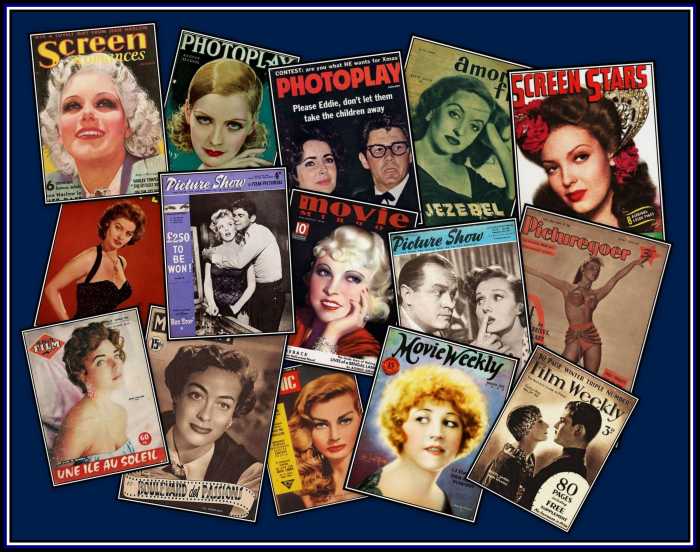
By the
late 1950s, television
sets were found in an
ever increasing number in
homes causing cinema
ticket sales to fall.
Following the decline, ABC
diversified and expanded
into television
production and
management. As the ticket
sales continued to fall,
increasing numbers of
cinemas belonging to all
circuits were facing the
threat of closure. Some
cinemas were saved either
permanently or
temporarily by their
conversion into Bingo
Halls, Billiard Halls or
shopping centres.
In 1967, Seven
Arts, now the owners
of Warner Brothers,
sold its interest in
their ABC cinemas
to EMI. However,
in 2000, following
various changes in
ownership, the
then-owner, Cinven
merged all remaining
operational ABC
cinemas with one-time Rank
cinemas and renamed
them Odeon.
Currently the Odeons,
with a new logo, form
part of the largest
cinema chain operating in
Europe.
In
addition to the major
circuits, there were
several minor ones with
cinemas in most areas of
London. Despite most
people having access to
these cinemas, their
sheer lack of number and
their lack of access to
the majority of first
run films produced by
the main American and
British production
companies saw to it that
they were never a threat
to Rank and ABC.
These circuits included
the Essoldo, Granada
and Classic. The Granada
and Essoldo chains
were granted access to first
run films only when
no cinema belonging to Rank
or ABC was close
by. This was perhaps more
noticeable outside big
cities. For example, the
town of Slough once had
three cinemas operated by
the Granada circuit:
the Granada, the Century
and the Adelphi.
Since neither Rank
nor ABC owned
cinemas in the town, Granada
was permitted to screen premier
films from all of the
main production companies
in these cinemas.
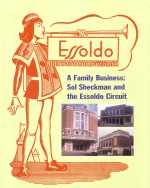 The
Essoldo chain was the
largest independent chain
and was founded in 1930
by Soloman Sheckman as S.S.
Blyth Kinemas, Newcastle.
The company was very much
a family concern and the
name Essoldo came
from the first names of
his wife, ESther,
himself, SOLomon
and his daughter, DOrothy.
After Mr. Sheckman's
death in the late 1960's,
the circuit was
controlled by his brother
Captain Mark Sheckman.
Most Essoldo
cinemas were named for
the chain, but with an
occasional variation, as
was the case with the Empress
in Hackney. The
Essoldo chain was the
largest independent chain
and was founded in 1930
by Soloman Sheckman as S.S.
Blyth Kinemas, Newcastle.
The company was very much
a family concern and the
name Essoldo came
from the first names of
his wife, ESther,
himself, SOLomon
and his daughter, DOrothy.
After Mr. Sheckman's
death in the late 1960's,
the circuit was
controlled by his brother
Captain Mark Sheckman.
Most Essoldo
cinemas were named for
the chain, but with an
occasional variation, as
was the case with the Empress
in Hackney.
Essoldos
showed films that had
already gone on General
Release or else were
not wanted for showing by
the major circuits.
However, in the early
1950s, once 20th
Century Fox began
producing its films in CinemaScope,
the company insisted that
the cinemas showing their
films adhere to certain
strict standards and
requirements including
equipping all theatres
with four-track
stereophonic sound.
This led to a
disagreement between Fox
and the Rank
Organization who were
distributing their films
at this time. Settlement
was not reached and Fox
looked elsewhere for a
circuit to distribute its
films. Seizing the
opportunity, the Essoldo
chain stepped in and
offered its cinemas to Fox.
The management of the
Essoldo chain was
happy to agree to all the
demands made by Fox
and so became a force in
the business. For several
years, the Essoldos
enjoyed good business by
showing many first run
films that patrons wanted
to see. However, Fox
and Rank eventually
overcame their
differences and the Essoldo
circuit returned to its
previous screening policy
of showing films of less
than sterling quality. In
1972, the remaining
cinemas still in
operation were sold to Classic.
Granada
was founded by Sidney and
Cecil Bernstein in 1930.
The names of the Granada
cinemas were named for
the chain for the most
part. However, what they
lacked in imagination in
this respect, they more
than made up for in their
astonishingly and exotic art
deco décor. Many
gave the impression that
the patron had entered a Moorish
Palace and were
remarkable in appearance.
I remember going to the Granada
in Stratford and
being astonished by its
décor and architecture.
I don’t recall ever
going to another Granada
after that until I
moved from London. Granada,
like Essoldo, struck
a deal with 20th
Century Fox to
present their films,
but with the decline
of ticket sales, the
cinemas were either
closed or turned into
Bingo Halls. Many were
demolished, which
considering their
architectural merit is
unfortunate. In 1988, the
five remaining cinemas
were sold to Cannon and
in 1991 the Bingo Halls
were sold to Bass
Leisure.
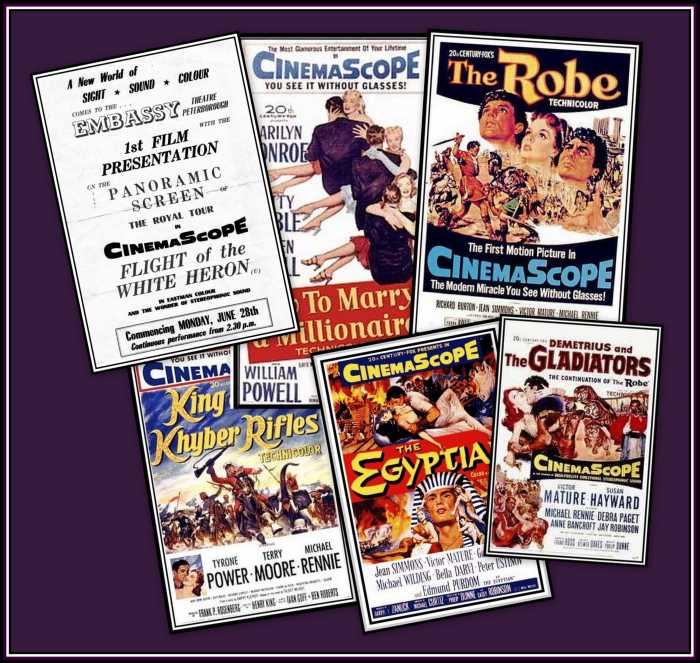
There was
only one cinema in the
whole of my area of the
East End that had a
relationship to the Granada
circuit, albeit distant.
Unfortunately, by the
time I became aware of
this establishment
its exterior had been so
transformed that it no
longer resembled the
original design. Sadly,
it certainly could not
then be mistaken for a Moorish
Palace. At the time
that I knew of the
cinema, it showed many of
the films shown by the Essoldo
circuit. This cinema, the
Standard, was
tucked away between London
Fields and the Hackney
Road. It was a
remarkably miserable
looking place and closed
once ticket sales went
into decline. It became a
Snooker Hall for a
while and perhaps a Bingo
Hall, but soon closed
permanently. The building
has long since been
abandoned and has
remained derelict for a
number of years now. I am
amazed that the corpse
of the building is still
present and has not been
raised to the grounds to
make way for more luxury
apartments that the
inhabitants of the area
can ill-afford.
The
Classic Cinema Group was
found by E.A. Rhodes. Its
cinemas were simply
called the Classic
in London, but were
distinguished from each
other by the addition of
their geographic
location, as with the Classic,
Baker Street, the Classic,
Kings Road, Chelsea,
the Classic, Strand etc.
Unfortunately, we had no Classic
in my part of the East
End, which I found most
annoying as a child. The Classic
chain was interesting in
that its cinemas
generally screened double
features of
previously released
popular films. They also
specialized in screening double
features of films of
one particular star. Classics
were the forerunner of
the art house and
the revival cinema.
I am grateful to the Classics,
since once I developed
some maturity in my taste
in film, these cinemas
became a constant
source of education and
pleasure, as they allowed
me to see some great
films, which would have
otherwise been left to
decay in a vault
somewhere in a salt mine
in Utah and never seen by
me. Naturally with the
advent of television
companies such as Turner
Classic Movies and
various rental video
stores and companies,
such a wonderful cinema
circuit could not,
unfortunately, maintain
its place in our society.
As wonderful as it is to
be able to view a video
in the comfort of
one’s own home, once
one has attended the
screening of a classic
film in a renovated picture
palace, a patron
cannot but be left
saddened at the demise of
the Classic
circuit and wish for its
return.
Although
cinemas and going to
the pictures were
important to us as kids,
we had no interest
whatsoever in circuits
and distribution
rights. We were
interested in what was
showing and where
it was being shown.
However, this was not to
say that we had no
interest in the type of
cinema that we went to.
Far from it for we would
rate them according to a
strict scale.
Classification was based
not only on the types of
films shown at the
cinema, but consideration
of its current state
of grandeur or lack
thereof also formed part
of the assessment. Should
a cinema be damned, it
was generally damned
forever. A cinema rarely
recovered from such a
sentence. As the East End
was a poor working class
area, many cinemas
received poor assessments
and so dismissed as dumps.
Whenever such a cinema
found its way into
conversation, it would
only be done through the
use of the most
derogatory of terms.
Disparaging remarks were
always welcomed by kids
and would bring forth the
most raucous of jeers and
sneers by the fellow
conversationalists. We
were harsh and cruel in
our assessments. However,
cruel we might have been,
but pragmatists, we also
could be. For when a film
of interest was
advertised to be shown at
what we had classified as
a dump, we would turn
down our noses and
swallow our pride and
graciously deem to enter
the establishment and
expect to enjoy the film.
At the top
end of the assessment
scale, in all its pride,
stood the picture
palace. This type of
cinema was indeed grand
and often glorious.
Many were truly
remarkable and some were
architectural wonders. It
should be remembered that
at the time that I
writing about, travel was
not a common occurrence
for most of the
inhabitants of the East
End. Some had no doubt
traveled abroad during
their military years, but
few had ventured outside
England on their own and
many had not even crossed
London. I remember taking
a bus ride with my
grandmother. As we passed
through the City, I asked
her if she knew where she
was. She looked at me in
a questioning manner and
said that she thought
that we were in Whitehall.
She had never been to
the City before and had
mistaken The Mansion
House for Whitehall.
So for most people, the picture
palace was perhaps
the most ornate building
that they had ever seen
and as near as many ever
got to the wonders of
the world.
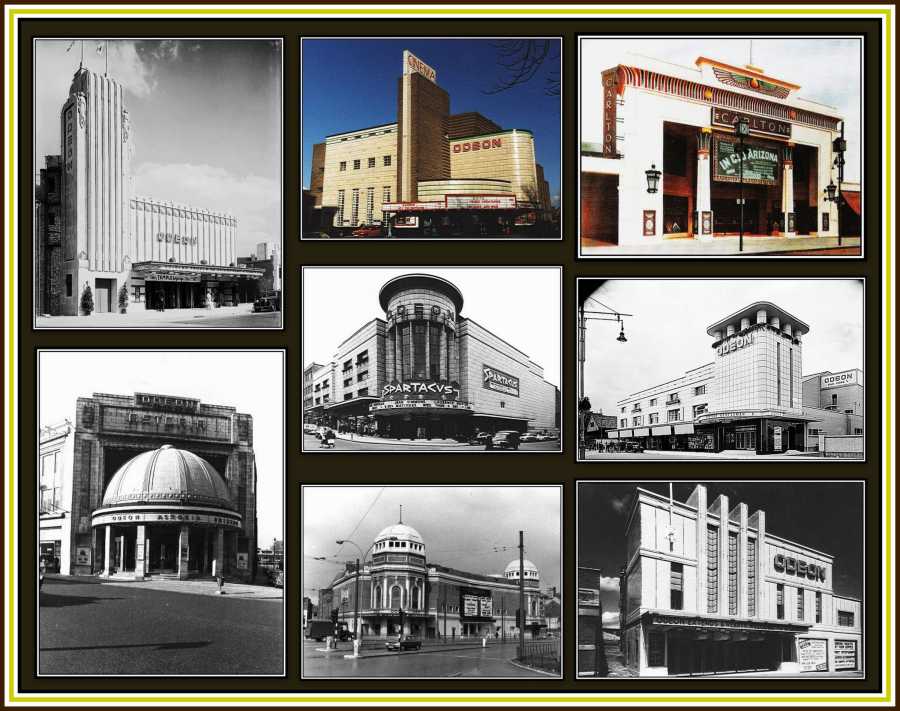
(click
on the pictures above to
enlarge)
Many
of the palaces had
exotic names, which often
reflected the
architecture and in the
remarkable and stunning
décor of the foyer and
auditorium. Other palaces,
although superficially
less spectacular, were
nonetheless admirable and
displayed an elegance in
their understatement.
From the very second
patrons stood before a palace,
they could not
fail to feel a sense of occasion.
This feeling was quickly
reinforced as they made
their way up the one or
two steps from the street
and passed through the
heavy wood and glass
doors that opened into
the foyer. Immediately,
patrons were astonished
by the overwhelming grandeur
and beauty of this
anti-chamber and by the
magnificence of the
staircase that swept up
to the balcony. Ceilings
would be elaborate and
often illuminated by
carefully concealed
lighting. Breathtakingly
beautiful coloured glass
chandeliers that defied
description hung from the
ceiling and cast a
delicate light over the
activities below. Most
often there would be an
assortment of potted
plants tastefully
positioned about the
foyer. The walls were
decorated with still
photographs of the stars
featured in the films
showing that week or in
the coming ones to come.
Friendly, elegantly
dressed staff members in
the livery of the circuit
were present to greet and
direct patrons to the box
office where a charming
young lady in similar
attire would request your
preference for seating.
Once told, she would push
the appropriate lever and
the number of tickets
would spring out of a
small slot ready for the
patron to collect.
Another staff member
would next usher ticketed
patrons to the entrance
of the auditorium where
yet another staff member
would be waiting to
inspect the tickets and
offer directions through
to the auditorium.
No matter
how grand and glorious
the foyer and the
staircase to the balcony
were, nothing could
prepare the patron for
the sheer marvel that
they were about to see.
The patron could not fail
to be overwhelmed by the
sheer brilliance and
majesty of the
auditorium. For magnificent
it would be. The
imaginative design gave
the impression that
perhaps the patron had
mistakenly wandered into
the court of a potentate
or perhaps into the
temple of some Eastern
god. Others, although
less ostentatious in
their simplicity, were
nonetheless as remarkable
as their more grandiose
counterparts. Such
auditoria achieved an
unassuming elegance
through tasteful and
delicate choices of
colour and décor
together with a minimum
use of objets
d’art.
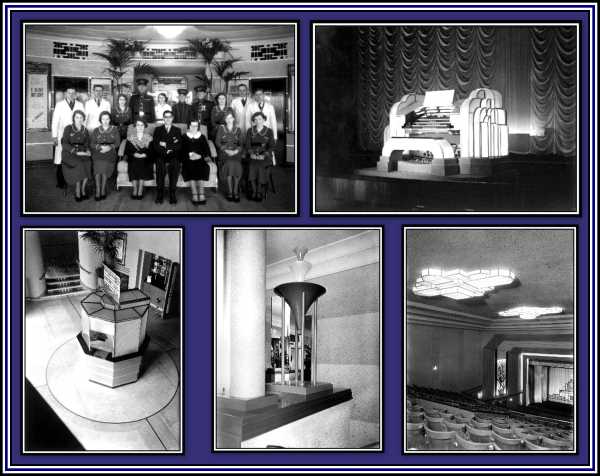
The
management of the picture
palaces made great
efforts to see that
patrons were treated
respectfully and saw to
it that enjoyed their
visits. The staff took
great pride in working in
such places and did all
they could to see that
the evening was memorable
for everyone. The
patrons, for their part,
saw going out for the
evening to a picture
palace as something
special, an occasion,
and behaved accordingly.
Such places, although
welcoming to well-behaved
children, were certainly
not places for kids out
for fun and a certain
amount of trouble. They
were places for kids to
marvel and places where
their imagination could
roam free as they gazed
at the splendor about
them.
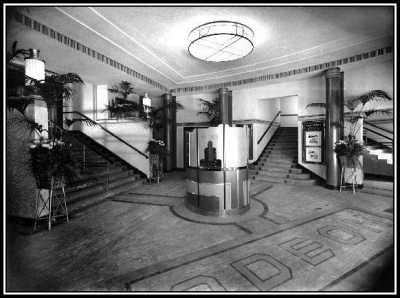 The
picture palace was
a place where families
went as a group for a
pleasant night out. They
were also the haunt of
young lovers and those
hoping to be so. These
cinemas were places where
young men took a young
woman on their first date
with the hope of
impressing her with his
sophisticated manner.
These were places where
less scrupulous males, males
on the make, brought
female companions in the
hope that by creating a
good impression, they
would enjoy some return
on their money later in
the evening. The palaces
were decorative, well
maintained and offered an
atmosphere conducive to
whatever the patrons
wished it to be. Many
offered refreshments and
light meals in their
tearooms complete with table
service. Patrons were
encouraged to meet their
friends in these
elegant tearooms and
enjoy a meal prior to
the showing. Since
children were welcome in
these establishments, they
carried no license for
alcohol sales. Most palaces
were equipped with an
organ, which would be
played prior to a
performance. It was
unfortunate that this
form of entertainment was
in decline when I was
ready to go to these
places with serious
intentions. The
picture palace was
a place where families
went as a group for a
pleasant night out. They
were also the haunt of
young lovers and those
hoping to be so. These
cinemas were places where
young men took a young
woman on their first date
with the hope of
impressing her with his
sophisticated manner.
These were places where
less scrupulous males, males
on the make, brought
female companions in the
hope that by creating a
good impression, they
would enjoy some return
on their money later in
the evening. The palaces
were decorative, well
maintained and offered an
atmosphere conducive to
whatever the patrons
wished it to be. Many
offered refreshments and
light meals in their
tearooms complete with table
service. Patrons were
encouraged to meet their
friends in these
elegant tearooms and
enjoy a meal prior to
the showing. Since
children were welcome in
these establishments, they
carried no license for
alcohol sales. Most palaces
were equipped with an
organ, which would be
played prior to a
performance. It was
unfortunate that this
form of entertainment was
in decline when I was
ready to go to these
places with serious
intentions.
If the picture
palace was at the
high end of the scale for
charm and elegance, the dump
would occupy a place
further down on that same
scale. These cinemas had,
to coin a phrase, seen
better days. Many may
have been elegant at some
time, but perhaps with a
change in management or
else its withdrawal from
a circuit, a
decline from favour had
occurred. Unfortunately,
the majority of cinemas
known to me as a child in
Bethnal Green were of
this type. However, and
let us be clear on this
point, the dump
would often screen
wonderful films that
would cause a patron to
develop a soft spot for
such an establishment.
This was most certainly
the case for myself and
several neighbourhood
cinemas. As superficially
dreadful as a dump might
appear, it would seem
like a virtual palace
when compared to a
flea pit.
The flea
pit was most
definitely at the bottom
end of our assessment
scale. Whereas the palace
was exotic, full of
charm and mystic, and the
dump might offer a
certain familiarity and
coziness, the flea pit
was totally lacking
in pretense and offered
no comfort, no elegance
or certainly no concern.
Firstly, let me say that
whether flea pits
actually had fleas is
questionable. However the
name is apt, as those of
you that remember them
will willingly vouch.
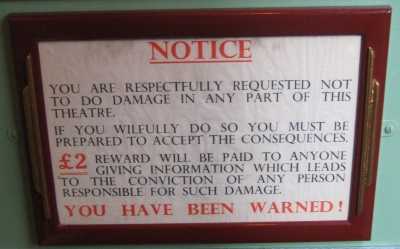 Flea
pits were rough
looking places both from
the outside and on the
inside. They lacked even
a modicum of
grandeur, offered no
comfort and were staffed
by those with a laissez-faire
attitude. From the
outside, one was
immediately horrified by
the image this cinema
presented to the world.
The front was
often dirty and generally
in need of paint. There
were no architectural
points of interest to
attract the passer-by.
Some even lacked a foyer.
Here the patron purchased
a ticket through a small
window that opened
onto the street. Next
the unsuspecting ticket
holder passed directly
through a door adjacent
to the box office
window and found himself
thrust directly into the
auditorium. Those that
had foyers did little to
make them inviting.
Potted plants were
nowhere to be seen and
pictures and posters were
never changed and only
seemed to advertise films
of yesteryear. Flea
pits were rough
looking places both from
the outside and on the
inside. They lacked even
a modicum of
grandeur, offered no
comfort and were staffed
by those with a laissez-faire
attitude. From the
outside, one was
immediately horrified by
the image this cinema
presented to the world.
The front was
often dirty and generally
in need of paint. There
were no architectural
points of interest to
attract the passer-by.
Some even lacked a foyer.
Here the patron purchased
a ticket through a small
window that opened
onto the street. Next
the unsuspecting ticket
holder passed directly
through a door adjacent
to the box office
window and found himself
thrust directly into the
auditorium. Those that
had foyers did little to
make them inviting.
Potted plants were
nowhere to be seen and
pictures and posters were
never changed and only
seemed to advertise films
of yesteryear.
The staff,
such as they were, were
not dressed in any
special livery and could
only be, at best,
described as grumpy.
At the entrance to the
auditorium, there would
be a person with a bulldog
mentality waiting at
a curtain to inspect
tickets. Such a person
always seemed to hate
children and would be
most unpleasant in both
greeting and demands.
This person would warn
kids that any trouble
and ya out! Got it? How
could one resist such an
invitation?
Once ushered
through the curtain, the
way to the auditorium
proved dark and
dangerous. The patron was
left to find his own way
from then on. The
auditorium had few house
lights and generally no
floor lights to aid to
the poor traveler. As a
result, a patron might
stumble over feet and an
occasional leg, which had
been splayed out into the
aisle for added comfort.
Even the projected film
did little to illuminate
the route to a seat since
the poorly adjusted arc
lamp would flicker and
darken and so bring
patrons difficulty in
following the action
besides impeding those
wishing to use it to
light their way to
safety. Eventually, after
suffering threats and
perhaps the odd projected
missile, the patron
hopefully became
accustomed to the dim
light and so could
gingerly ease his way to
an empty seat.
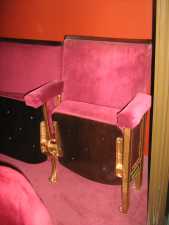 The
seats were generally
ripped and most of the
stuffing had long since
been lost. It was not
uncommon to find an
occasional spring
sticking out, which would
cause much unpleasantness
to the unsuspecting. The
seat covering had long
ago lost its pile and
would have appeared shiny
had there been sufficient
light to see. However,
the finding of a seat
that could actually be
sat on always proved
difficult in a flea
pit, as most were in
a poor state of repair
and many were broken. The
seats were generally
ripped and most of the
stuffing had long since
been lost. It was not
uncommon to find an
occasional spring
sticking out, which would
cause much unpleasantness
to the unsuspecting. The
seat covering had long
ago lost its pile and
would have appeared shiny
had there been sufficient
light to see. However,
the finding of a seat
that could actually be
sat on always proved
difficult in a flea
pit, as most were in
a poor state of repair
and many were broken.
The
majority of seats were
deficient in repair due
to lost screws not being
replaced. This rendered
the seat loose and once
sat upon would place the
patron in a precarious
position. Others had
seats that opened too far
thereby causing the
seated patron to risk
slipping off during his
enjoyment of the film. As
with most unfortunate
events, there was a silver
lining to such a
happening since problems
with the seat would
bring his companions much
amusement and break the
monotony should the film
be proving dull. 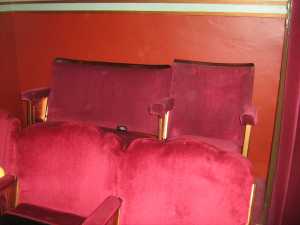 However,
the real danger to the
patron lay in those seats
that lacked a seat all
together. Allow me to
digress: the reader may
have noticed that kids
have a particular way of
sitting down in a cinema
seat. They like to push
themselves against the
back of the seat and then
bring their bottoms down
onto the seat. In this
way, their weight forces
the seating to open and
causes them to fall into
it. This gives them a
great deal of pleasure.
To return to the
description of the seats
of the flea pit:
when a young patron
pushed himself back
against a seat, his hope
was that there would
actually be a sit to rest
himself on. Oftentimes,
this would not be the
case and the young patron
would then find himself
on the floor in the midst
of old ice cream wrappers
and tubs and various
other forms of debris.
The sounds made by his
falling would be greeted
with much pleasure by the
audience about him.
Filled with
embarrassment, the young
patron would not only
have to get up, dust
himself off, but next run
the gauntlet, as he
attempted to find a seat
that could be sat upon.
His soon-to-be erstwhile
friends would gain added
pleasure should he be
holding a drink or some
other form of messy
foodstuffs, as these
would undoubtedly be
spilled on him much to
his vexation. However,
the real danger to the
patron lay in those seats
that lacked a seat all
together. Allow me to
digress: the reader may
have noticed that kids
have a particular way of
sitting down in a cinema
seat. They like to push
themselves against the
back of the seat and then
bring their bottoms down
onto the seat. In this
way, their weight forces
the seating to open and
causes them to fall into
it. This gives them a
great deal of pleasure.
To return to the
description of the seats
of the flea pit:
when a young patron
pushed himself back
against a seat, his hope
was that there would
actually be a sit to rest
himself on. Oftentimes,
this would not be the
case and the young patron
would then find himself
on the floor in the midst
of old ice cream wrappers
and tubs and various
other forms of debris.
The sounds made by his
falling would be greeted
with much pleasure by the
audience about him.
Filled with
embarrassment, the young
patron would not only
have to get up, dust
himself off, but next run
the gauntlet, as he
attempted to find a seat
that could be sat upon.
His soon-to-be erstwhile
friends would gain added
pleasure should he be
holding a drink or some
other form of messy
foodstuffs, as these
would undoubtedly be
spilled on him much to
his vexation.
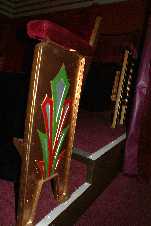 One
last point about seating
in the flea pit,
and then I promise to
move on, comes from One
last point about seating
in the flea pit,
and then I promise to
move on, comes from a
something told
to me by an American
friend. It seems that flea
pits were once
universal, as there was
such a movie house
in Cleveland, Ohio. This
establishment was
commonly known amongst
the kids of the area, as
the Rat Hole, and
was greatly despised by
patrons. This name should
tell the reader
everything that they
needed to know about this
place. Apparently, it
readily fulfilled the
criteria for
classification as a flea
pit and had gained
its unique name from
there being an actual rat
hole visible to the
clientele at the
baseboard beneath the
screen. I am assured that
rodents were often seen
scampering around and
that broken seats were
the norm here. Once, as
my friend was making her
way along a row, she
arrived at what she
assumed was an empty
area. With some relief
and a wish to sit and
start enjoying the film,
she collapsed back
into the seat in the
usual manner, as
described earlier, only
to be greeted by yelps
and slaps. Apparently, a
thin person was already
installed in the seat and
had taken none-too-kindly
to being sat upon. I
assume that tubs of
popcorn and vast
containers of sweet
ice-cold drinks were
thrown about the place,
as my friend slipped to
the ground perhaps along
with her seating
companion. I am afraid
that my laughter, which
accompanied the telling
of this tale, caused my
friend to discontinue her
story. Apparently, I was
meant to sympathize with
her and not find the
situation amusing.
Fortunately, my
imagination was easily
able to fill-in what she
refused to tell, so all
was well.
The floors
of the flea pits
were not only filthy and
littered with the debris
accumulated from days of
no cleaning, but were
also a source of danger
to the patron. The
carpet, when present, was
generally worn and very
much the worse for wear.
Often it would come with
large gaping holes that
proved invisible in the
dark and would prove
traps for the
unsuspecting patron who
might innocently catch
his foot in one and so be
launched headlong further
along the aisle, again
much to the amusement of
those about him. Most
certainly, the carpet
would show signs of burns
resulting from stubbed
out cigarettes. Mind you,
such an event was
inevitable since all
ashtrays were either long
since absent or else
jammed full, as no one
ever emptied them.
Flea
pits were notorious
for their amenities, or
rather for the lack of
them. When present, they
were generally in a poor
state of repair and
rarely cleaned. Parents
warned their children not
to go to the toilet at a flea
pit. It was thought
that they harboured dirty
old men that would
lay in wait for an
unsuspecting youth to
wander in. Parents would
also warn their children
to never ever go
to a flea pit
alone and to never
ever sit next to an
adult who was alone. Most
parents outright forbad
their children to go to
such a cinema. My mother
made it quite clear that
I should never ever
go to one and I was made
to promise her faithfully
that I never would.
Naturally, I did not
listen, but I never did
go to such a cinema alone
and I never ever
went to the toilet while
there and I never ever
sat next to a lone adult.
Had such a man sat next
to me, I would have moved
seats or else left.
The one
advantage of the flea
pit to a kid was that
you were not bothered by
the staff unless your
group became especially
rowdy or if a large fight
broke out. Should this
happen, there would be no
discussion and no
reasoning, and everyone
and anyone that was grabbed
was tossed out of the
building: no questions
asked and no explanation
given or accepted. One
could sit with one’s
feet up on the seat in
front, smoke, mess around
and generally have a good
time. After all, one was
there for anything and
everything except to
watch the film, which
would generally be old
having been released
years earlier.
The worst flea
pit known to me was
this really awful cinema
on the Roman Road.
However, it was the first
cinema in the area to
open for regular
performances once the war
ended. I am ashamed to
say that it was here that
I saw my very first film,
Walt Disney’s
Snow White and the Seven
Dwarfs. Apparently I
had been nagging, on and
on, that I wanted to see
this film and so my
mother took me. I am sure
that at this time, it had
not acquired its flea
bitten status, but
even then, it could never
have been likened to a picture
palace. Over the
years, this place kept
deteriorating and became
quite dreadful judging by
the outside. I can not
say that I ever went
inside again. I could not
bring myself to go. This
cinema was so awful that
it had long since lost
its name. No one ever
referred to it by
name and whenever it was
referred to, it was
simply called that
dump. Quite apt, I
thought. During my one
and only visit to that
dump, I remember not
liking the wicked
stepmother and
spending a lot of time
under my seat for I was
fearful that this hag
would carry me off. This
poor cinema was
demolished sometime in
the ‘60s and has
since made way for a
block of flats with a
series of shops occupying
the ground floor. As ugly
as these flats and shops
may be, they are a marked
improvement over that
dump.
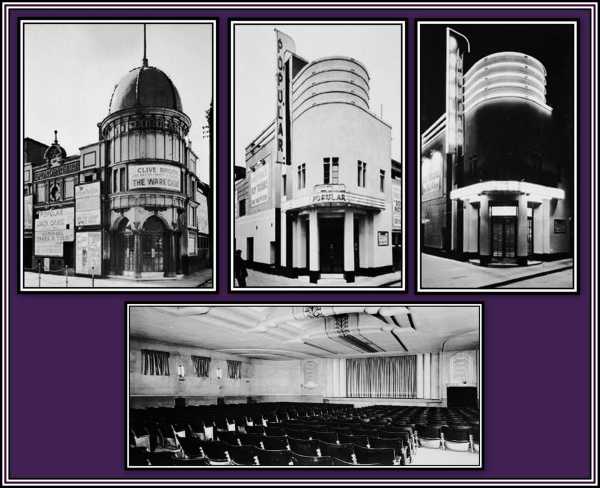
The
Popular Cinema, Stepney
The other
truly terrible cinema
that I can recall was in
Stepney. This place had a
name, but I am unable to
recall it. I think that
it belonged to the Classic
chain, but I cannot
be sure. However, I find
this hard to believe
since the Classics
belonged to a small chain
of cinemas that
specialized in showing classic
films. The one film that
I saw there was The Marx
Brothers in A night in
Casablanca. The
auditorium was truly
miserable. Most of the
seats were broken and
rest of the décor was
dirty and frayed. The
picture flickered
and the sound quality did
not allow you to actually
hear much dialogue. I
remember frustration grew
amongst the mostly young
clientele and they became
very noisy. This lack of
quiet obviously annoyed
one of the few adults
present and soon a scuffle
broke out, which quickly
turned into a
fully-fledged battle
between various factions
of the neighbourhood.
Poplar was always a rough
area and I had been
strictly forbidden to
ever go there, but had
disobeyed and gone anyway
with a group of chums.
Soon, the warring
factions were going at
it full pelt and this
necessitated the house
lights being raised. This
shone little light on the
goings on since
most were broken. I
remember a few ushers and
a man in a suit trying to
regain order, but failing
miserably. I also
remember finding the
whole scene to be quite
funny and began to laugh.
Laughter was soon turned
to concern and then fear
when several small skirmishes
now broke out in the rows
in front and behind us.
Since we were not a part
of the local crew,
we became fearful that
our entry onto Stepney
turf would be
discovered and the
warring hoards could well
unite and turn their
combined might on us.
Quickly and with little
noise, we beat a hasty
retreat out of that place
and into the sunlight.
Once outside, I began
laughing again. In spite
of this, the flea pit
had a definite place in
my society.
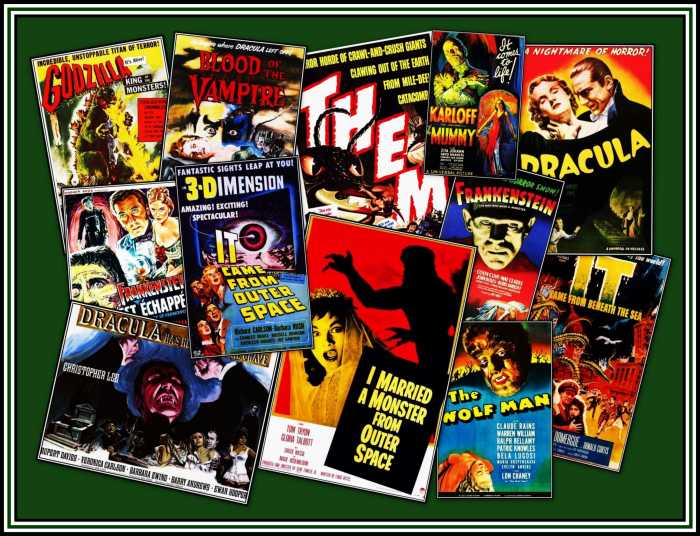
I would
like to thank Mr. Kevin
Wheelen and Mr. Brian
Hall for providing the
photographs used here. I
am truly grateful to them
for their time and
effort.
AFTER
THOUGHT
I have
been told by a friend of
mine that the most
awful cinema in the Roman
Road in Bethnal Green
was in fact named the Empire
and the one in Stepney
was named the Popular.
My friend asks me not to
be too harsh on the
poor old place. He
informed me that cinemas
deteriorated badly during
World War II, in fact up
to 1955, when building
restrictions were finally
lifted. Apparently until
then, it was virtually
impossible to get
permission for even minor
repairs to anything but
industrial buildings and
housing in Britain. By
1955 many of the independent
cinemas were
struggling to make ends
meet against the
onslaught of commercial
television. As a result,
cinema audiences were
dwindling rapidly and
cinemas began to close.
My friend
urged me to remember that
once cinemas such as the Empire
and the Popular, as
the collage shows, would
have been new and smart
and he reminds me to
think of all the pleasure
it gave over the decades.
He also, sadly, reminded
me that by the time my
favourite cinema, the Excelsior
closed, the carpets were
thick with grease, the
seats were broken and
unstable and the screen
was patched.
I have to
confess that I feel
humbled and ashamed and
will be wearing sack
cloth and ashes for a
while.
PETER
THURGOOD wrote:
I was born
and brought up in Bethnal
Green and my
childhood memories of the
area are very fond ones.
Although I haven't lived
in the East End
for some 37 years now,
whenever anyone asks me
where I am from I still
reply Bethnal Green
and I always will!
I used to
go to the Empire on
Roman Road with friends,
mostly during the school
holidays or for ‘Saturday
Morning Pictures’.
It was mayhem in
there, but we loved it.
One reason why we loved
it so much was that the
staff never seemed to
bother to ask you your
age, which meant we could
get in to see an adult
picture without actually
being accompanied by an
adult. Incidentally, our
name for the Empire was
the ‘Bug
‘ole’ not
the ‘Flea
Pit’!
In those
days, we did not always
have enough money to go
to the pictures. Despite
this, we often found a
way into the Empire that
did not cost us anything.
This involved one of us
paying to get in. He
would then slip into the
toilets, which was where
the emergency doors were,
and open them up to let
the rest of us in. I saw
many films this way.
Another
fond memory that I have
of that cinema was that
it was here that I was
introduced to smoking. I
remember that along with
two of my friends, we
bought clay bubble pipes
and a box of matches took
them with us to the Bug
‘ole. Once
inside, we searched all
of the little brass
ashtrays, which were
placed on the backs of
the seats, and collected
any dog-ends that
still had tobacco left in
them! We filled our clay
pipes with the tobacco,
and smoked it. I can't
say I found it was an
enjoyable experience, but
it has made for an
amusing tale to tell
others, which I have done
over the years.
One final
and lasting memory
of the Bug ‘ole comes
to mind now that I am
sitting and writing. The
place had it own
distinctive smell. It was
unique and I have never
experienced it anywhere
else that I have been.
The odour was musty! I
hate to thing what
combinations of solids,
liquids and gases went
into its making. I
remember that we tried to
hide this odour
with the smoke from our
pipes, but failed
miserably!
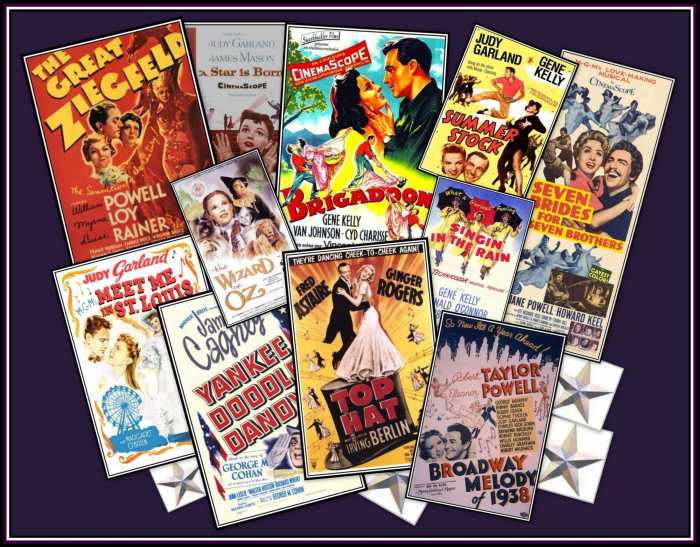
|